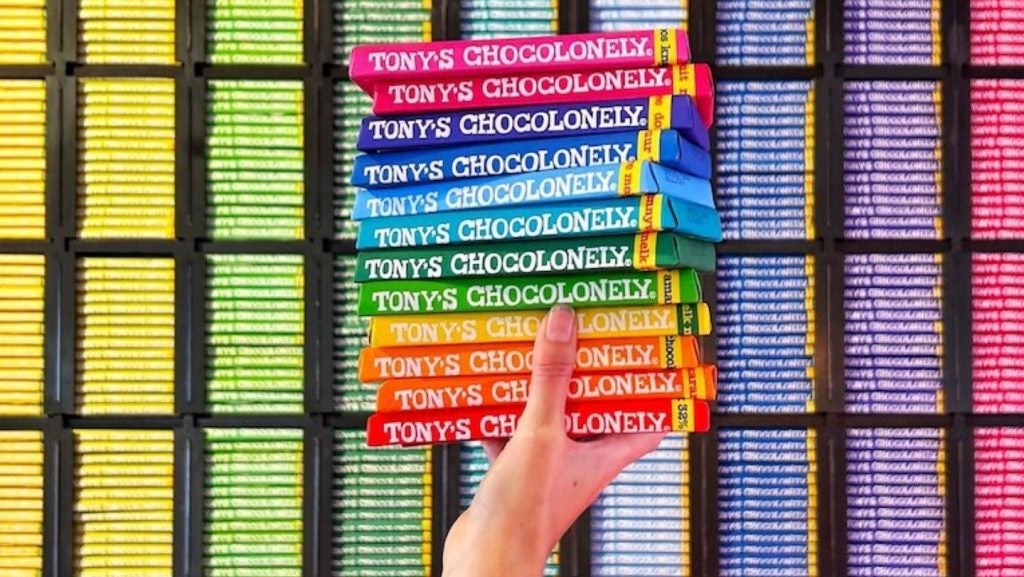
Tony’s Chocolonely is a fair-trade chocolate company based in the Netherlands known for its stunt-marketing campaigns criticising big chocolate companies.
The business’ main markets are the Benelux countries, where the company says it accounts for 20% of the large chocolate bars segment. Alongside the Benelux, it has built a presence in Germany, Austria and the Nordic countries, a group of four markets Tony’s calls its “golden markets”.

Discover B2B Marketing That Performs
Combine business intelligence and editorial excellence to reach engaged professionals across 36 leading media platforms.
However, the company also does business in markets including the UK and Ireland, with the most recent major new territory for the brand being the US, where it launched through Walmart in April.
Just Food sat down with to Ben Greensmith, Tony’s UK and Ireland country manager, to discuss the cost of cocoa, the importance of paying farmers “a fair price” and wanting to show the rest of the industry a new way of sourcing and paying for the ingredient.
Eszter Racz (ER): The recent spikes in cocoa prices have been a major talking point in the chocolate sector. What impact have they had on Tony’s and how do you think they might have affected how consumers view the supply chain?
Ben Greensmith (BG): The last six months have been pretty shocking in terms of what’s happened to the price of cocoa and the cause of it has been climate problems. We had really hot weather in west Africa, which is where more of the world’s cocoa comes from and we had a lot of rain. It washed a lot of flowers away.
There’s also a problem with something called swelling shoots [cocoa swollen shoot virus disease], which is a disease killing a lot of the trees. That’s led to a really poor yield for the farmers in west Africa. This season, [production] is down about 30%. That basically forced the price of cocoa up. Now you’ve got a handful of traders in the middle, who are making all the money.

US Tariffs are shifting - will you react or anticipate?
Don’t let policy changes catch you off guard. Stay proactive with real-time data and expert analysis.
By GlobalDataWe would never celebrate anything getting more expensive, particularly in the cost-of-living crisis but I think the positive is that what this is starting to do is to shine a light on the problems of the farmers.
ER: So, you are saying the rise in cocoa prices is the result of the exploitation and poor practices in the industry, rather than solely due to climate-related factors?
BG: So, one of the problems is climate change but the other one is decades of underinvestment in cocoa farms. The big companies haven’t been paying enough, the farmers haven’t been able to invest in their farms and future-proof them.
So you’ve got 2.5m farmers that are basically living in poverty and these big chocolate companies are making billions at their expense.
And suddenly, their yields are down as well.
So until recently, none of that money [coming from the sales of chocolate] has been going back to the farmers. It’s all been going to the traders and speculators in the middle.
What we’re hoping is this plight is going to start to shine a light on the problems in west Africa and the farmers not being enabled to earn a living income.
ER: Have you seen changes in demand for Tony’s products?
BG: No, we haven’t seen that [trade-down] at all and we don’t expect to. We don’t expect that the company will have to increase marketing activity or anything like that.
We haven’t seen cocoa prices in the market for consumers, so for you and me, move yet, because there’s a bit of a lag between when the cocoa is bought and when it’s put into the products from the big chocolate companies. Typically it’s around six months to a year. It’s inevitable that, in the next six months, these product prices are gonna start going up around the world. What we hope happens is that soon some of that money starts going back to the farmers and the beginning of the value chain.
Also, people if they’re going to buy chocolate, they tend to buy brands for that treat. We’re not seeing a trade down into own-label. Because people have less money at the moment, they’re eating out less but what they are doing is treating themselves at home a little bit more.
ER: How has this crisis impacted your strategy? Did Tony’s have to increase retail prices?
BG: What we’re going to constantly have to do is review our costs, input costs and the cost of cocoa. It’s having a massive impact on anyone who is sourcing cocoa so, as with any business, we’re having to review and make some choices. But, ultimately, we’re not going to change what we do, we might just have to make some adjustments to the profit and loss management.
Even in this difficult time, we need to demonstrate that we can grow – and we can continue to grow – in a profitable way, whilst also doing the right thing for the farmers at the beginning of the value chain.
At the moment, we’ve got that disconnect where you’ve got the big chocolate companies who are spending loads on marketing but totally ignoring the problem at the beginning of their value chain, which is paying those farmers a fair price.
ER: Amid fierce competition, what market share can Tony’s realistically reach and how do you plan to get there?
BG: Those four big markets [the Benelux, the Nordic countries, Germany and Austria] are what we call our golden markets. They are our priority markets.
If we’re going to change things and disrupt the cocoa industry, then these countries are the homes of massive chocolate companies but also massive chocolate consumption as well.
So last year our turnover was €150.2m ($163.3m) and this year we expect to do just shy of €200m.
ER: In the UK and Ireland, what’s the company’s vision for the size and market share the business could reach at retail?
BG: We are growing at over a 40% rate in the UK. After five years of trading in the UK, we’re the fourth-biggest chocolate bar brand. We have more than a 4% market share.
For us, market share and making a profit on chocolate are never a goal but it’s a means to achieving a goal, which is basically raising awareness and showing there’s a different way to make chocolate. We would never say from a UK perspective we want to get to 30% market share but we do need to get big enough to show what we’re doing to those big chocolate companies.

We have to show them what we’re doing is scalable. If we can grow to a certain size, then there’s no way that those big chocolate companies can still look at us and go: ‘Well, we can’t do what you’re doing. We can’t source the way that you’re sourcing. We can’t pay the money that you’re paying, because you’re small.’
We account for about 0.5% of the cocoa that comes from west Africa. In the next ten years, we want 10% of the cocoa to be coming through our value chain.
ER: That sounds like a significant jump. How is Tony’s Chocolonely going to achieve that?
BG: There’s two ways that we’ll do that: one is growing Tony’s brands. The other way is saying to companies this is how we do it. We pay a higher price to enable the farmers that we work with to earn a living wage and importantly that means they can get out of poverty. This year, it means we’re paying about 70% on top of the farming price but that’s voluntary. That enables farmers to earn a worthy living income.
We have a fully traceable supply chain, all of the cocoa is tracked and traced. We visit all the farms every year. It means we take responsibility for how that cocoa is sourced.
We work with them to have long-term agreements so they can plan for the future. We help them with diversification as well.
That’s how we will get 10% share of all the cocoa coming out of West Africa. One, through Tony’s brand, two, enabling other companies to copy us.
ER: Would the company offer to source and sell cocoa to its larger rivals, or produce their chocolate instead of showing them the way?
BG: We wouldn’t do private label but we would tell those big retailers to sort their private labels through our value chain. We basically say to them that this is the model. We’re going to help you to copy that model. We’re not going to produce it for you because otherwise we become part of the problem.
We basically say it’s an open-sourcing model. This is what we’ve learned over the last 20 years. Please copy us because we’re never going to get to 100% market share.
But if we can get Waitrose and Tesco, Sainsbury’s and then also ultimately those big chocolate companies [to copy our resourcing principles], that’s how we’re going to change things and make an impact, and that’s how we’re going to help the farmers in west Africa.
ER: Who is a typical consumer of Tony’s Chocolonely products?
BG: We definitely appeal to a slightly younger chocolate buyer. We’ve just wanted launched into Walmart in the US, which is the world’s biggest retailer, and it’s flying there. We are breaking all the boundaries. We don’t only appeal to a more affluent shopper. What we found with Tony is that in a relatively short period of time with a low marketing budget, we’ve got 82% brand awareness in the UK. The big chocolate companies are only around 90%.
What’s different with Tony’s is we have really high brand advocacy. Nine out of ten people that try a Tony’s bar fall in love with it and come back to buy it again.
ER: Has Tony’s Chocolonely so far mainly launched in wealthier countries because of the premium price point of its products? Are consumers in these countries more able to make choices more based on ethics and sustainability?
BG: I think what we’re proving is that whilst we are slightly more expensive than your average chocolate bar, we’re not crazy expensive. What we’re showing is that it transcends and goes across … it is and the aim for us is to become a household name and a national brand in every single market that we are bringing [the product] because that is how we show those chocolate companies that what we’re doing is scalable. We can’t afford to be niche.





